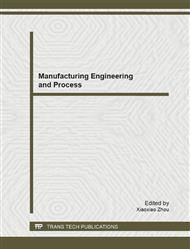[7]
The role of VC tube in Fig. 4 is in order to achieve a new form of compensation. Fig.7 shows compensation schematic, VC is to choose voltage for the power winding, when VC turns on each phase is powered by a capacitor otherwise by AC power supply. The relationship between the source voltage and capacitance voltage is shown in Fig. 6, when the supply voltage is 0, the phase voltage is provided entirely by the capacitor voltage, so (2) Where θd is conduction angle, so (3) Simulation Results This compensation not only reduces the torque ripple due to the voltage fluctuation, but also improves the power factor of control system. Fig.8 shows the simulation curve based on MATLAB/SIMULINK that SRM operated on dual closed loop control, and considering the two-phase excitation mode power factor correction. And the speed is given as 2000rpm, SRM load torque is 7N.m. Fig. 8 The input voltage, input current, trigger logic per phase, VC compensator logic, output current and bus voltage of two-phase excitation SRM under PFC AC input voltage is the sine curve with amplitude of 310V, while the input side of the current curve from the traditional single-pulse envelope curve to the form of multi-pulse which improves voltage phase to follow the sine curve, the average value is the same as cycle single pulse. The third screen in Fig.7 shows in the initial turn-on time of each phase, VC is always conducting and its amplitude is decided by initial phase of conduction time, the conduction time can be calculated by the above formula. Phase current during normal operation is shown in screen 4. By way of compensation, the phase voltage is approximately the average DC as shown in screen 5. Conclusion This paper focuses on the traditional rectifier filter mode in SRM power topology power supply side current distortion in the serious problem of low power factor, based on two-phase SRM excitation mode of the time, switched reluctance motor drive circuit of the power topology of the power factor correction. Topology through the work of the new power mode of presentation, combined with the capacitor voltage of each phase voltage compensation analysis, making the supply side of the current waveform envelope of a sine wave burst approximation, which greatly improved the power factor [10]. At the same time as the input AC side of the case directly, through the compensation capacitor voltage has been more stable phase voltage, reducing the torque ripple and improve the system stability. Refernces
Google Scholar
[1]
Honghua Wang, Switched Reluctance Motor Drives [M]. Beijing: China Machine Press, 1995 (in Chinese).
Google Scholar
[2]
Jianhua Wu, The Design and Application of SRM [M]. Beijing: China Machine Press, 2000(in Chinese).
Google Scholar
[3]
G. H. Rim, W. H. Kim, E. S. Kim, and K. C. Lee, A Choppingless Converter for Switched Reluctance Motor with Unity Power Factor and Sinusoidal Input Current, IEEEIPESC, pp.500-507, 1994.
DOI: 10.1109/pesc.1994.349690
Google Scholar
[4]
L. Caruso, A. Consoli, G. Scarcella, and A. Testa, A Switched Reluctance Motor Drive Operating at Unity Power Factor, IEEE/IAS, p.4101117, 1996.
DOI: 10.1109/ias.1996.557057
Google Scholar
[5]
Y. A. Kwon, K. J. Shin, and G. H. Rim, SRM Drive system with Improved Power Factor, IEEE/IECON, pp.541-545, 1997.
Google Scholar
[6]
M. Barnes, and C. Pollock, Power Factor Correction in Switched Reluctance Motor Drives, IEE Conference on Power Electronics and Variable Speed Drives, pp.17-21, 1998.
DOI: 10.1049/cp:19980493
Google Scholar
[7]
Dong-Hee, Zhen-Guo Lee, Single-Phase SRM Drive With Torque Ripple Reduction and Power Factor Correction, IEEE Transactions on Industrial Applications, vol. 43, no. 6, Nov/Dec 2007.
DOI: 10.1109/tia.2007.908162
Google Scholar
[8]
Yong Ahn Kwon and Kyoo Jae Shin, SRM Drive System with Improved Power Factor, Industrial Electronics, Control and Instrumentation, 1997. vol.2, pp.541-545.
DOI: 10.1109/iecon.1997.671791
Google Scholar
[9]
K.M. Tsang, W.L. Chan, Adaptive control of power factor correction converter using nonlinear system identification, IEE Proceedings-Electric Power Applications, Appl. vol.152, no.3, pp.627-633, May 2005.
DOI: 10.1049/ip-epa:20045058
Google Scholar
[10]
M.Orabi and T.Ninomiya, Nonlinear dynamics of power-factor-correction converter, IEEE Transactions on Industrial Electronics, vol.50, no.6, pp.1116-1125, Dec 2003.
DOI: 10.1109/tie.2003.819576
Google Scholar


